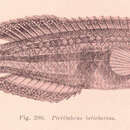fr
noms dans le fil d’Ariane


Pictilabrus laticlavius és una espècie de peix de la família dels làbrids i de l'ordre dels perciformes.
Els mascles poden assolir els 23 cm de longitud total.[2]
Es troba al sud d'Austràlia (des del sud d'Austràlia Occidental fins a Nova Gal·les del Sud, incloent-hi Tasmània).[2]
Pictilabrus laticlavius és una espècie de peix de la família dels làbrids i de l'ordre dels perciformes.
Pictilabrus laticlavius, the patrician wrasse, the senator wrasse, the green parrotfish or the purplebanded wrasse is a species of marine ray-finned fish from the family Labridae, the wrasses. It is found in the eastern Indian Ocean and the south western Pacific Oceans off he temperate coasts of southern Australia.
Pictilabrus laticlavius has a moderately deep laterally compressed body, in which the height is 26-32% of its standard length. The head is quite large and is equipped with relatively large eyes and a small mouth in which the upper jaw does not reach the eye. The jaws are armed withsmall, canine-like teeth, the front pair in the lower jaw and the front two pairs in the upper jawbeing enlarged and recurved and there is and enlarged canine on each side of the posterior end of the upper jaw. This species has moderately large, cycloid scales which are firmly attached and which cover its body, although the head is naked apart from one to three rows scales on the cheek and eight to ten large scales on the gill cover. The lateral-line shows an abrupt downwards curve below the rearmost spines in the dorsal fin. The dorsal fin is continuous, with an elongated base and it is uniform in height along its length. The anal fin is similar to the posterior portion of the dorsal fin and is placed opposite it. The caudal fin is truncate while the pectoral fins are short and rounded and the pelvic fins are aloe short and are positioned with their origins underneath the base of the pectoral fins and do not reach the vicinity of the anus.[3]
The males of this species are mainly green with maroon or purplish stripes along their flanks. The females and juveniles are reddish to greenish-brown in colour and have a row of black spots above their lateral line as well as 4-5 blackish bars on their lower flanks and a black spot on the posterior portion of the dorsal fin.[3]
Pictilabrus lacticlavius is endemic to the waters off temperate southern Australia from New South Wales to southern Western Australia,[1] its distribution extends from Bryon Bay in New South Wales to the Houtman Abrolhos in Western Australia and extends to Tasmania[3]
Pictilabrus lacticlavius lives in rock reefs which are clothed in weed,[4] occurruing to depths of 40 metres (130 ft).[2] This is a carnivorous species and its prey includes a variety of invertebrates including gastropods, amphipods and small shrimps and crabs.[3]
Like many wrasse, P. lacticlaviatus is a protogynous hermaphrodite and shows sexual dichromatism in which the females hold territories which overlap while the males, at least when breeding, guard an exclusive territory. The spawining season depends on locale, occurring earlier in the Spring farther north and later in the cooler waters of the southern parts of its range. They can reach sexual maturity within a year and with a total length of greater than 95 millimetres (3.7 in). In 3 years they can reach a total length of 180 millimetres (7.1 in) and they live for at least 4.8 years and they may live as long as 10 years. They change sex from female to male when they attain a total length of approximately 130–150 millimetres (5.1–5.9 in), which is at an age of around 2 years old in New South Wales and may take between at least 3 and 5 plus years in Tasmania.[1]
Pictilabrus lacticlavius is a quarry species for angling[1] and may also be caught as bycatch by commercial fisheries.[3]
Pictilabrus lacticlavius was first formally described as Labrus lacticlavius in 1840 by the Scottish naval surgeon and naturalist John Richardson (1787-1865) with the type locality given as Port Arthur in Tasmania.[5] When the American ichthyologist T.N. Gill described the genus Pictilabrus in 1891 he designated Labrus lacticlavius as its type species.[6] The genus name is a compound of picti meaning "painted" and labrus which is the type genus of the wrasse family, Labridae, and may derive from the Greek labrax meaning a specific type of fish.[2] The specific name refers to the blue spots on the fins which Richardson considered to resemblethe clavi on the borders of the Roman patrician clothing.[3]
Pictilabrus laticlavius, the patrician wrasse, the senator wrasse, the green parrotfish or the purplebanded wrasse is a species of marine ray-finned fish from the family Labridae, the wrasses. It is found in the eastern Indian Ocean and the south western Pacific Oceans off he temperate coasts of southern Australia.
Pictilabrus laticlavius es una especie de peces de la familia Labridae en el orden de los Perciformes.
Los machos pueden llegar alcanzar los 23 cm de longitud total.[1]
Se encuentra al sur de Australia (desde el sur de Australia Occidental hasta Nueva Gales del Sur, incluyendo Tasmania ).
Pictilabrus laticlavius es una especie de peces de la familia Labridae en el orden de los Perciformes.
Pictilabrus laticlavius Pictilabrus generoko animalia da. Arrainen barruko Labridae familian sailkatzen da.
Pictilabrus laticlavius Pictilabrus generoko animalia da. Arrainen barruko Labridae familian sailkatzen da.
Pictilabrus laticlavius is een straalvinnige vissensoort uit de familie van lipvissen (Labridae).[2] De wetenschappelijke naam van de soort is voor het eerst geldig gepubliceerd in 1840 door Richardson.
De soort staat op de Rode Lijst van de IUCN als niet bedreigd, beoordelingsjaar 2008.[1]
Bronnen, noten en/of referenties黃條繡隆頭魚,為輻鰭魚綱鱸形目隆頭魚亞目隆頭魚科的其中一種,分布於澳洲南部及塔斯馬尼亞海域,棲息深度可達40公尺,體長可達23公分,棲息在海草生長的礁石區,生活習性不明。